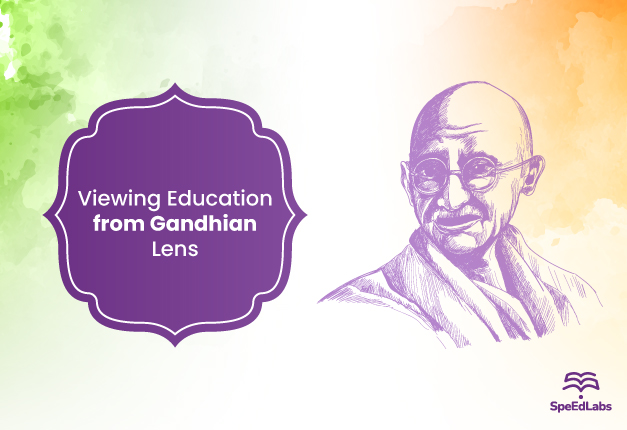Teachers instruct students and help them become knowledgeable, whereas a guru cultivates a disciple’s desire to learn and sees to his overall development. We might think that his ideas hold less relevance today but this thought process would be fallacious.
Literacy and Education
Gandhi distinguished between literacy and knowledge and held that literacy in and of itself was no education. In a letter to his son Manilal written from Volksrust prison in 1909 in which he stated, “Education does not mean a knowledge of letters but it means character building.” The growth of the human personality was far more important than the acquisition of more knowledge and tools of the mind. He believed that real education should be achieved through a particular way of living in a community rather than just through formal instruction in schools. Schools should train students to be peaceful, nonviolent members of society by teaching them to live by the principles of cooperation, truth, and ahimsa.
Education for All
To ensure that education reached as many people as possible at the grassroots level, Gandhiji thought that the mother tongue should be the medium of instruction up through the primary level. He believed that everyone should have access to education for at least fourteen years, and as a result, laws promoting free education have been passed. Gandhi had a vision for a system of education that would support a person’s overall personality development. He emphasised the need for mandatory training in fundamental skills such as farming, horticulture, cotton spinning, wood art, blacksmithing, pottery, etc. in addition to basic education (primary and middle level).
Gandhian View of Education
The essential tenets of education as propounded by Gandhi can be summed up as follows:
The goals of education must be in line with the principles of freedom, truth, and nonviolence.
- Equality for all men and all religions.
- Equal weight should be given to manual labour and intellectual training, both of which should be productive and useful in society.
- Mother tongue is used as the primary language of instruction at all levels, and Hindi is a subject that must be taught.
- Serving the needs of the villagers should be the goal of the curricula and other arrangements.
- A fundamental tenet of all Gandhian institutions was that teachers should view untouchability as a stain on Hindu society and work to eradicate it. They should also never exclude a boy or girl because of his or her untouchability or treat him or her differently once they have been admitted.
- Gandhian education included a lot of manual labour. He used to say that focusing solely on brain development is pointless. One must use their hand to develop their brain.
Gandhi worked to rebuild rural areas, uplift the Harijan, and revitalise politics, so he was always aware of what the average person was experiencing. The social order he cherished could not be created, he realised, unless education was given a new focus. He unveiled to the nation a plan that he had been developing for 40 years—a plan that is popularly known as the Wardha Scheme of Education but that he referred to as “Nayee Talim” or New Education—and that he had been working on for 40 years. Education for life and throughout life, according to his definition.
Before they were developed and made known to the public, Gandhi’s educational ideas were developed through his educational experiments with his family and in his ashrams in South Africa and India. By education, he meant an all-around drawing out of the best in the child and man—body, mind and spirit.
The Joy of Sharing
Gandhi constantly experimented to discover the truth and to live it following his light. This light never stopped illuminating his awareness and spreading the light among those he worked with and for.
He had the gift to learn and grow with the experience of events in daily life and the principles he held, evolved out of his experiences and experiments.
Gandhi’s ideas about resolving conflicts through nonviolent, non-violent means rather than through violent conflicts between classes, castes, or communities, eliminating poverty and inequality, about “small is beautiful,” protecting the environment, honesty and probity in public life, about his belief in pluralism, and open society and an open polity are all still very relevant today. The Prophet would see a poet and an India in a vision:
“Where the mind is without fear and the head is held high; Where knowledge is free, Where the world has not been broken up into fragments by narrow domestic walls; Where tireless striving stretches its arms towards perfection; Where the clear stream of reason has not lost its way into the dreary desert sand of dead habit; Where the mind is led forward by thee into ever-widening thought and action—Into that heaven of freedom my father, let my country awake.”
His Ideas in the Recent Education Policy
Gandhi’s educational principles were abandoned in independent India. However, today, we’re highlighting the value of skill development and vocational education once more. One can see why Gandhi placed such a high value on character development as being essential for the building of a nation when one considers the state of the nation, which is marked by increasing violence, rape, crimes against women, Dalits, and minorities, rising individual and corporate corruption, and a lack of moral standards.
Also published on Medium.
